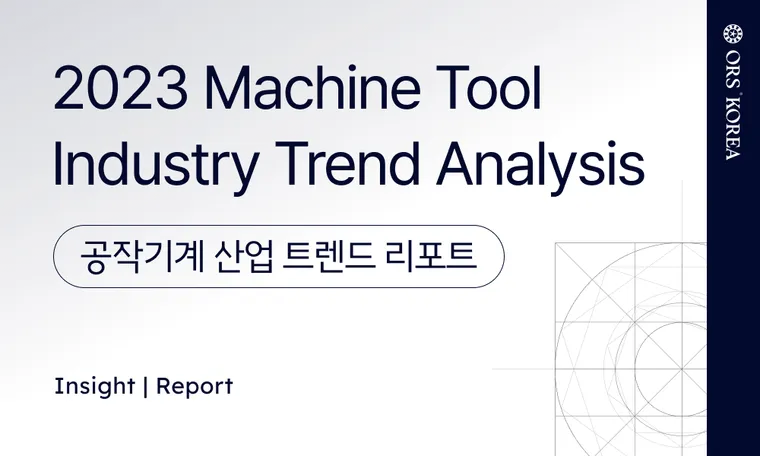
Expected CAGR (예상 연평균성장률) 5%
글로벌 공작기계 산업은 연 5프로의 성장률을 보일 것으로 예상 된다. 해당 산업은 응용 분야에 따라 자동차, 일반 기계, 정밀 공학, 운송 기계 등으로 나뉜다. 그 중 자동차 산업이 가장 점유율이 높다.
미래에는 정밀 공학 관련 분야가 가장 성장성이 높을 것이다. 기술의 발전과 더불어 복잡한 제품 제조에서 높은 정확도가 요구되기 때문이다. 기술적으로는 전통적인 공작 기계보다 CNC 기계의 수요가 높아질 것으로 예상된다. 산업 전반에 걸친 자동화 트렌드는 CNC 기계 분야의 성장성을 더 가속화 할 것이다.
The global machine tool industry is expected to show a steady annual growth rate of 5%. Within this industry, applications vary across sectors such as automotive, general machinery, precision engineering, and transportation machinery, with the automotive sector currently holding the largest market share.
Looking ahead, the field of precision engineering is anticipated to experience the most significant growth. This is attributed to the increasing demand for high precision in manufacturing, driven by technological advancements.
Technically speaking, there is a forecasted shift towards higher demand for CNC machines compared to traditional machine tools. The industry-wide trend towards automation is expected to further accelerate the growth of CNC machinery.
기술경쟁력 vs. 가격경쟁력 : 어디에 집중해야하는가?
고부가가치와 스마트화로 시장경쟁력 강화
공작기계 시장은 일본, 독일 등 선진국이 기술력을 바탕으로 시장을 주도하고 있고 중국 등 후발국이 가격경쟁력을 내세우고 있다. 한국은 중간급 분야에서 경쟁력을 확보중이지만, 고부가가치 공작 기계 및 스마트화, 자동화 솔루션에서는 두각을 나타내지 못하고 있다.
이러한 상황에서 미국과 유럽에서 공급망 재편이 이루어지고 있고, 해당 국가에서 대부분의 생산을 하게 된다면 중간재 수출 중심인 국내 산업 시장이 위축될 것이다. 따라서 앞으로 수요가 높아지는 첨단 제조 분야에서 경쟁력을 갖출 만한 기계를 만들어야 한다.
전기차의 수요가 확대되며 공작기계 산업에 변화가 있을 것이다. 내연기관에서 전기차로 바뀌면서 원래 부품의 60프로 이상, 약 만개정도의 부품이 사라질 것으로 예상되기 때문이다. 부품의 수가 줄었지만 이는 또다른 기회가 될 수 있다. 새로운 시장이 생기기 때문이다.
전기차로 전환되며 자동차 부품 가공과 관련하여 새로운 부품이 생겼다. 또한 부품이 복잡해지기 때문에 해당 부품과 관련된 기계의 수요가 늘어난다. 따라서 산업 트렌드를 잘 이해하고 비즈니스 기회를 포착하여 해당 시장에 진입할 수 있는 능력이 중요하다.
Technology vs. Price Competition: Where Should We Focus
Strengthening Market Competitiveness through High Value-Added and Smart Manufacturing
In the machine tool market, advanced economies like Japan and Germany are leading the way with their technological prowess, while emerging economies like China are competing on price competitiveness. South Korea is establishing its competitiveness in mid-range sectors but has yet to make a mark in high-value machine tools and the smart automation solutions segment.
With ongoing supply chain realignment taking place in the United States and Europe, where most production is likely to be concentrated, South Korea's industrial market, which heavily relies on intermediate exports, may face challenges. To thrive in the growing demand for advanced manufacturing, it's imperative to develop machines that can compete effectively in these high-tech sectors.
The shift towards electric vehicles (EVs) is expected to bring significant changes to the machine tool industry. As internal combustion engines are replaced by EVs, over 60% of original parts, roughly around ten thousand components, are expected to become obsolete. While this reduction in part count may seem challenging, it also presents a new opportunity, as a whole new market is emerging. The transition to EVs is creating new components related to automotive part machining, and the increasing complexity of these components is driving demand for machinery tailored to their production.
In conclusion, understanding industry trends and seizing business opportunities in response to these changes is crucial. It's essential to adapt to the evolving landscape and have the ability to enter emerging markets effectively.
Written By Shin Minju
Business Development Intern
ORSKOREA


